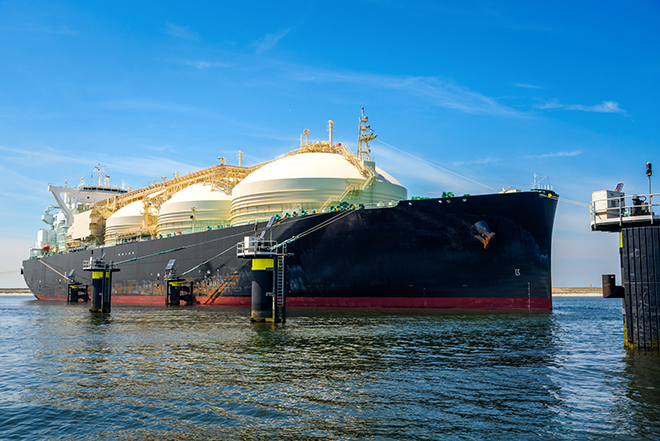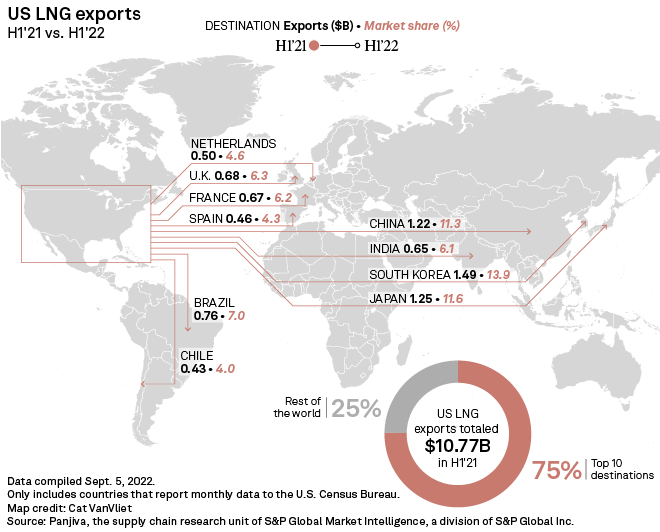S&P Global Offerings
Featured Topics
Featured Products
Events
S&P Global Offerings
Featured Topics
Featured Products
Events
S&P Global Offerings
Featured Topics
Featured Products
Events
Banking & Capital Markets
Economy & Finance
Energy Transition & Sustainability
Technology & Innovation
Podcasts & Newsletters
Banking & Capital Markets
Economy & Finance
Energy Transition & Sustainability
Technology & Innovation
Podcasts & Newsletters
S&P Global Offerings
Featured Topics
Featured Products
Events
14 Sep, 2022
By Corey Paul and Anna Duquiatan

|
A liquefied natural gas tanker docks at the Port of Rotterdam in the Netherlands. |
Surging demand for U.S. liquefied natural gas saw the total dollar value of cargoes exported during the first half of the year nearly double from the same period in 2021, underscoring the importance of the American commodity to energy-thirsty global markets.
Global imports of U.S. LNG totaled more than $21.2 billion in the first six months of 2022, compared to about $10.8 billion in the first six months of 2021, according to data from Panjiva, a business line of S&P Global Market Intelligence that provides news and analysis about global supply chains.

Europe leads imports
Many U.S. LNG export cargoes departed for Europe in the first half of 2022 as the war in Ukraine prompted a scramble for LNG supplies. The European energy crisis has continued, and LNG market experts have warned that shipments of LNG cannot quickly replace curtailed pipeline imports from Russia and that the region's need for significant LNG volumes will remain strong.

European gas prices have remained higher than anywhere else in the world, including Asia. Platts assessed the Dutch Title Transfer Facility month-ahead benchmark price for Europe at an all-time high of €319.98/MWh on Aug. 26, or about $93.81/MMBtu, according to data from S&P Global Commodity Insights. The benchmark price was assessed at €191.98/MWh on Sept. 12, or about $57/MMBtu.
France was the top destination for U.S. LNG shipments during the first half, with exports to the country totaling about $3.4 billion, according to Panjiva. Spain ranked second at about $2.5 billion, followed by the U.K. at about $1.7 billion.
The largest importer of U.S. LNG outside of Europe was South Korea, the fifth-largest overall exporter during the first half with shipments totaling about $1.3 billion during the six-month period.

The months ahead
High spot LNG prices worldwide and tight gas market dynamics since mid-2021 have incentivized U.S. LNG export terminals to run close to full bore. Total exports have dropped since an early June fire at the Freeport LNG Development LP terminal in Texas led to an extended outage at the facility, which could resume partial production in November. But U.S. LNG exports remain robust headed into the winter. The U.S. Energy Information Administration recently forecast that exports would average 11.7 Bcf/d in the fourth quarter, a 1.7-Bcf/d increase from the third quarter, and would keep rising to average 12.3 Bcf/d in 2023.
Weather will be a major risk factor for the global LNG supply and demand balance heading into the final months of 2022. A cold winter could exacerbate the energy crisis in Europe, which is expected to face increased competition from major Asian buyers seeking to refill storage volumes.
In the meantime, the global gas crunch is continuing to drive a wave of commercial activity tied to new U.S. LNG supplies. But building multibillion-dollar LNG export facilities takes years, and how quickly new projects can come online will be a key issue for a global gas market facing a supply shortfall.
S&P Global Commodity Insights produces content for distribution on S&P Capital IQ Pro.
